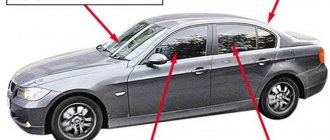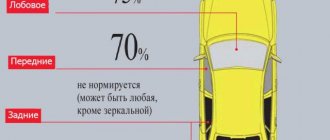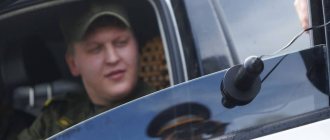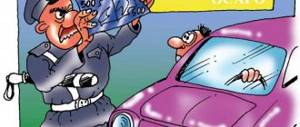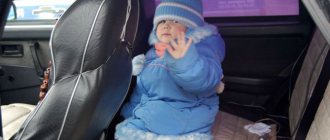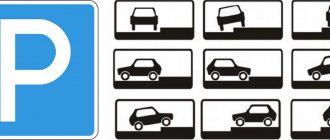Why are car windows tinted?
Window tinting has been popular among car enthusiasts for many years. Its practicality lies in the fact that the interior of the car heats up less in the sun; it is not necessary to drive in sunglasses. And there is a common joke among drivers that a tinted car is the key to a happy family. On the roads of the Russian Federation you can find many cars of different categories with tinted windows. Tinting can vary from opaque to just a light coating. About ten or fifteen years ago, the most advanced drivers boasted that their windows were completely covered with a mirror film, blinding not only other drivers, but also pedestrians. But gradually this fashion faded away.
It should be said that the active struggle of the authorities against tinting car windows is predominantly Russian know-how. In the vast majority of other countries, they practically do not fight it. In the United States of America, Canada, Great Britain, Japan, Australia, and New Zealand, you can often see mirror-tinted cars on the roads. The laws of these countries do not prohibit the use of chrome car parts, but they glare in the sun, blinding other drivers. Perhaps such a tolerant attitude in economically developed countries is a tribute to democracy. About ten years ago, the UK authorities tried to ban the tinting of car windows at the legislative level. But this caused a storm of indignation among car owners and taxi drivers. Therefore, it never came to pass the law. The authorities of Ukraine and Belarus long ago passed laws that prohibited mirror tinting of car windows and established standards for regular tinting. But in practice, it turns out that these laws have been forgotten and there is practically no control over their compliance.
Tinted windows are very practical
Is it possible to tint the headlights
Headlights can be tinted, but this also has its limitations. If the film absorbs more than 15% of the light, such tinting is considered illegal in 2021, which will result in a fine.
Often even factory tinted headlights violate these rules. But this fact does not exempt you from liability, and a traffic police officer can issue you a decree. The Code of Administrative Offenses does not say anything specifically about tinting the front or rear headlights, so this issue requires individual consideration.
Standards for tinting car windows in Russia
Drivers who are not particularly experienced in the laws believe that car windows cannot be tinted at all. But they are wrong. There are certain standards for tinting car windows, but exceeding them will be a violation.
At the moment, it is allowed to tint the rear window of a car in any way, with the exception of mirror film. The tint film is not limited in light transmittance standards. You can also tint the rear side windows of your car in the same way. There is one thing though. This is only allowed if the car has both rear view mirrors. Even when the tinting of the rear and side rear windows of the car is minimal, visibility using the rear view mirror installed in the car's interior is significantly limited. Therefore, it is necessary that its tasks are duplicated by external side mirrors. If traffic police inspectors stop a car with a tinted rear window and only one rear-view mirror, this will be considered a violation of the Road Traffic Regulations. In this case, there are two options to avoid a fine: either install the missing mirror in front of the traffic police inspectors, or remove the tint in front of them.
Restrictions exist only for the windshield and front side windows of the car. They can be completely tinted, but provided that the light transmittance of the film is not lower than 70%. A film can be applied to the side windows, the width of which does not exceed 14 cm. It is not subject to light transmission restrictions, and the width may be smaller.
In 2015, the standards for tinting car windows changed slightly. Previously, tinting with a light transmittance of at least 75% was allowed.
The rear window can be tinted to any degree
Car headlight tinting
Headlight tinting has a direct bearing on road safety. Naturally, darkened headlights cannot be linked to terrorism in any way. But Russian legislation considers that tinting film glued to the headlights of a car is a much more serious offense than its tinted windows.
Experienced drivers and road safety experts unanimously agree that tinting car headlights has no practical purpose. In most cases, it becomes a tribute to fashion, without serving any practical purpose.
Russian drivers tint their headlights quite often. The color of the film, as a rule, harmonizes with the color of the car itself. Some people want a contrasting color. Drivers like that the light of their car is different from the light of other cars. When tinting car headlights, a special film that is resistant to high temperatures or a varnish that has the same characteristics is used. The vinyl film protects the headlights from small stones and, if necessary, can be removed relatively easily. It is much more difficult to remove the special tinting varnish; in this case, most likely, you will have to replace the headlights themselves.
While a lot has been written about the standard for tinting car windows in Russian legislation, the regulatory articles regarding tuning headlights contained in the Administrative Code of the Russian Federation are quite vague. Claims to tinted headlights are described in more detail in the Technical Code and regulations for technical inspection of a vehicle.
The biggest violation is considered to be tinting the car's headlights red. A film of a different color can be applied, but only if it occupies no more than a quarter of the area and its light absorption is not higher than 15%.
Tinting taillights is not prohibited, but traffic police officers can issue a fine of five thousand rubles or limit themselves to a verbal warning if the rear lights do not perform their functions. In addition, if a traffic accident occurs when one car rear-ends another equipped with tuned brake lights, then in this case the repair of the hit car is paid by the driver of the tinted car.
If the headlights were tuned by the manufacturer, then this does not cause complaints from the traffic police
Experienced drivers rarely resort to tinting their headlights. They know very well that in conditions of limited visibility, tuned lighting devices can lead to accidents, because color perception is distorted for other drivers participating in road traffic. Distortion will lead to the creation of an emergency situation. In the event of an accident, the owner of a car with tinted headlights will most likely be found to be at fault. Under no circumstances should you attempt to tune headlights yourself. After all, it will be very difficult to measure light transmittance. But tinted headlights are not always a problem. In the case when the car was released from the factory with tinted headlights, no penalties are imposed on the driver. After all, when producing cars, a car assembly plant is guided by regulatory documents. But this is only when the car was assembled on the territory of the Russian Federation. If the car is imported from abroad, then completely different tinting standards may apply. But even in this case, the driver of the car will not be fined, because all imported cars must comply with the standards in force in the Russian Federation. An official car dealer will not break the law and sell cars that do not meet the requirements.
Tinting car headlights can cause difficulties when passing a technical inspection. The Technical Code defines the requirements for vehicle lighting devices, and they are checked during technical inspection. In particular, the reliability of their fastening and performance are being studied. One of the points on the basis of which the inspection will be considered failed is the malfunction of the lighting equipment. And one of the reasons for its malfunction may be the presence of additional elements on the headlights, that is, a tint film or varnish.
How to properly tint windows and headlights
Before you decide to tint your car windows or headlights, you should study the characteristics of the tint film, as well as the car glass itself. After all, it is also not entirely transparent a priori. The level of light transmission of glass on different cars is different; this value is not static. A big role in measuring this indicator is given to the quality of the glass, its manufacturer, thickness and some other parameters.
After tuning, it is advisable to check the light transmittance
Typically, untinted glass has a light transmittance of 93–96%. If, during tuning, an additional film is used, the light transmission characteristics of which are equal to 70%, then ultimately the light transmission will become equal to 65%. In this case, we are talking about violation of traffic rules and a fine. In addition, the driver will be in for an unpleasant surprise, because he was confident that, according to these parameters, his car fully complies with the established requirements. And the money spent on tinting, one might say, was wasted.
It happens like this: all the light transmittance characteristics of glass and film are taken into account, all parameters fully comply with the standards. And when checking, it suddenly turns out that the level of light transmission is not at all the same as it was during the calculation. What is the reason? Poor quality work by craftsmen often causes deviations from the expected tinting parameters and light transmission levels. Therefore, it is advisable to contact highly qualified craftsmen who guarantee their work. It is very important to measure the level of light transmission after gluing the tint film. If it does not meet the standard, then you need to immediately file a claim and have the work redone, but at the expense of unscrupulous performers. When contacting specialists, you should first ask whether they have instruments for measuring light transmittance. It also doesn't hurt to find out if they are certified.
GOST for tinting
The level of car window tinting at the legislative level is determined by GOST 32565–2013. It clearly regulates the level of tinting of the windshield, left side and right side windows of the car. The document takes into account all parameters, from the technical characteristics of automobile glass to all possible manufacturers. It also specifies the parameters of the materials used for tinting. GOST does not apply when tinting the front and rear headlights of a car.
There are no restrictions on tinting brake lights, but it can create emergency situations
Ways to legally tint car windows
Recently, the concept of polymer coating has become legal, so glass can be tinted either using film or using special spraying. What tinting is allowed on front windows? It can be anything, it is only important to observe the light transmittance of the glass.
Darkening by applying a special coating is not very popular among motorists because it is short-lived and often of low quality. A thin layer of metal is applied to the surface of the glass without vacuum conditions. Such window tinting has a mirror effect and is similar in appearance to factory tinting, which is permitted by law; this advantage allows you to reduce the nagging of traffic police officers.
This is interesting: Heated wipers: classification, 5 stages of connection + instructions for making warm brushes yourself
The most popular are athermal tints that meet the requirements. There are mirror tinting and “chameleon” tinting. Mirror tinting is not prohibited by law, but as required by technical regulations, the presence of a mirror effect on a car is not recommended. This requirement is aimed at avoiding accidents associated with such tinting.
The car ahead may reflect headlights in the glass, which will distract the driver and impair control of the car. The light transmittance level of mirror tinting should not be lower than 60% to avoid the appearance of a mirror effect.
There is also an athermal “chameleon” tint. This type is considered safe because the light transmittance of films is usually at least 80%, which does not contradict the requirements of the law on tinting. When choosing a “chameleon” tint, you need to make sure of its quality; a good film does not contradict GOST.
Athermal tinting of front windows has become in great demand due to a large number of advantages:
- Does not reduce visibility. This tint is completely transparent, green or purple shades may appear.
- "Chameleon" reduces the heating of the car from the sun's rays and prevents parts of the car's interior from burning out.
- Thermal coating reduces the operation of the air conditioner, thanks to reliable protection from excess sunlight entering the interior.
- This method of darkening glass does not contradict the requirements of GOST, which allows you to protect yourself from prying eyes without fear of a fine.
You should not save on the tint coating, because only a high-quality film will have all the advantages listed above.
A new trend in car glass coating is electrochromic tinting. A similar species appeared in Russia relatively recently. It is worth noting that such tinting is very expensive, its cost reaches 80 thousand rubles. Therefore, this film is used only on expensive cars. There are two types of electrochromic tinting: regular - Smart, and self-adhesive - Smart Glass. “Smart” film has an important drawback - darkening on both sides, i.e. It's just as hard to see inside the car as it is outside.
Fans of deep tinting can tint the upper part of the windshield without restrictions, but the size of the coating strip should not be more than 140 mm.
How and where is light transmittance checked?
Inspection of the technical condition of a vehicle is strictly regulated by relevant laws and regulations. Order of the Ministry of Internal Affairs No. 1240, which until recently regulated the inspection of tinting, has been cancelled. Traffic police officers are guided by Order No. 1123 of the Ministry of Internal Affairs. This document abolished some norms that were in force before it came into force. In particular, we are talking about the right of traffic police officers to remove state registration numbers from cars that have exceeded the tinting standards. It was this circumstance that greatly frightened Russian drivers.
The state registration number is an integral part of the car. If it is missing, the vehicle cannot be operated. Accordingly, the removal of license plates implied the transfer of the car to a penalty area or the inability to further use it. It was quite difficult to collect license plates from the police; to do this, it was necessary to provide convincing evidence that the vehicle was in good condition and that there was either no tinting on the windows at all or that it complied with the requirements established by law. But removing the tint without moving the car is unrealistic. In general, the injured drivers managed to get out as best they could. Many tried to resolve the issue on the spot with the traffic police. And this often implied (to be honest) a significant corruption component. Therefore, there was simply arbitrariness on Russian roads when traffic police officers purposefully stopped almost all cars that had tinted windows. But after the abolition of the rule on removing license plates, the interest of traffic police officers in such car owners fell sharply.
Today's standards allow any police officer, including the traffic police, to check the level of light transmission of glass. The check does not happen by eye, of course. For this purpose, technical diagnostic tools are used, which must have appropriate certificates and also undergo periodic technical testing. Each device is entered into the State Register. The device passport must contain a note about the next diagnostic of its performance. Previously, it was possible to measure the light transmittance of glass only at a stationary post, but now this norm has been abolished - measurements can be carried out anywhere. The light transmittance of car windows is measured only when the glass surface is clean and dry. During rain or on a road dirty from wet snow, it is simply impossible to get accurate readings.
Traffic police officers have the right to check light transmittance, but only according to established rules
If a driver is stopped and traffic police officers want to measure the light transmittance of car windows, then they must insist on presenting the necessary documents: certificates of conformity, technical passport of the device used for diagnostics. Particular attention should be paid to the presence in it of a mark indicating the passage of periodic technical regulations. Police officers must provide permits for such actions. In the absence of any of the above documents, the results of diagnosing the light transmittance of automobile windows will be far from legal.
When checking the light transmittance of car windows, special sensors are attached to them. It is necessary to pay attention to the fact that they do not have artificial darkening and there is no external film on them. When the driver believes that the accuracy of the device is far from ideal, he has the right to request repeated or control measurements. In this situation, traffic police officers must carry out the following measurements in the presence of two witnesses. It is not the driver's responsibility to search for them. Therefore, the police try to stop cars and ask their drivers to act as witnesses. Receiving a request (we emphasize: just a request) from a police officer does not oblige the driver to gladly become an attesting witness. He may refuse, arguing that he is in a hurry to catch a plane, a meeting, work, and so on. Therefore, the police understand that finding a witness on a busy highway is not so easy. Yes, and among drivers there are certain unwritten rules that do not recommend drowning their colleagues, because none of the drivers can be sure that at the next meeting with the State Traffic Inspectorate patrol, he will not become a fellow sufferer. It is clear that finding two witnesses is often problematic. A potential violator is waiting, police officers are looking for witnesses...
If the process drags on and the police do not release the driver, then he has the right to remind them of the existence of Article 28.5 of the Code of Administrative Offenses of the Russian Federation, which considers the long delay of a vehicle by State Traffic Inspectorate officers to draw up a report unlawful. Particularly persistent inspectors may be encouraged to contact their management to clarify the situation. When a driver asks a police officer to provide him with the number of his immediate commander, interest in the driver, as a rule, immediately disappears for some reason. It is also advisable to have with you the hotline numbers of the Ministry of Internal Affairs, where you can voice your complaints about the actions of traffic police officers.
Video about communicating with the traffic police when checking light transmittance
A device for measuring light transmittance and features of its operation
Devices that measure the light transmittance of car windows are called taumeters. Typically police use Blik. It is portable, small in size, and usually works from the cigarette lighter of a stopped car. Therefore, the police ask the driver to connect the device’s plug to the car’s internal network. In this case, the car engine should not run. The device shows reliable operating parameters only when the internal network of the car is not lower than 12 volts. In this case, the driver can justify the impossibility of measurement by informing the traffic police officer that his battery is extremely weak and cannot provide adequate power. In this case, you can safely ask the officer to use the patrol car's battery and electrical system. It is unlikely that police officers will deal with this.
The Blik device is used in the temperature range from -10 to + 40 degrees. Measurements of the light transmittance of automobile glass are carried out at three different points. The arithmetic mean is used as an indicator of light transmission.
When conducting diagnostics, the driver must carefully observe the actions of the inspector. When fixing any error, you don’t have to talk about it. When the traffic police officer begins to draw up a protocol, then in it you need to write your disagreement with the conclusions and justify them with procedural errors made during the measurement of light transmittance. Defending your rights in such a situation is much less problematic. The police can either release the driver or demand a new measurement, but with the participation of two witnesses.
Taumeter is a small device
Calculation of the permissible darkening factor when choosing a film
Since the law allows the windshield to be darkened only within 25%, and the factory glass already has a small percentage of darkening (up to 10%), then when choosing a tinted film, preference should be given to the option where the darkening coefficient will not exceed 15%. Similarly, when calculating the permissible shading for the front side windows, you should choose a film with a shading coefficient of no more than 20% (allowed 30% - 10% of the existing shading of the windows).
This calculation will allow you to accurately comply with the state standard. If the glass on the vehicle is old enough, then its light transmittance is significantly lower than new glass. Therefore, you should either completely abandon tinting, or measure the light transmittance and, based on them, purchase a film with the desired coefficient.
Fines and other sanctions for tinting
At various times, the Russian traffic police tried to one degree or another to combat tinted car windows. Until 2014, cars whose tinting exceeded the established standards even had their license plates removed. And there was a time when tinting did not arouse any interest among the authorities. The fight against it is being carried out at the command of the federal authorities, which in some ways is reminiscent of the good old days of the USSR, because then any actions on the ground were initiated from above, often turning into all-Union hysteria.
Today, for exceeding the established standards for tinting car windows and headlights, measures are in force, defined by Part 3 of Art. 12.5 Code of Administrative Offences. The biggest offense is tinting a car's headlights red . For this you can lose your driver's license for 6 months or even a year. The headlights themselves will be confiscated. If a car with tuned red headlights is detained by traffic police in the dark, then you cannot drive it, it will be sent to a penalty area. But already during daylight hours or on a tow truck. This can only be avoided by immediately removing the film from the headlights.
Exceeding the light transmittance standards of the windshield and front side windows is an offense leading to a fine of 500 rubles. If the company’s car was released onto the road with technical violations, the person responsible for the condition of the vehicle faces a fine of 3,000, and a legal entity - 20,000 rubles. There are no penalties for repeat offenses yet. As well as other penalties.
Video on how to avoid a fine for tinting
https://youtube.com/watch?v=mA1-yBKibHU
Legislative initiatives
For the first time in the last few years, the issue of window tinting was raised within the State Duma in 2021. It was planned to increase fines for violating traffic rules, among which a special place was given to exceeding the established standard for window tinting. The initiator of the proposed innovations was Vyacheslav Lysakov, who holds the post of first deputy chairman of the State Duma. It was planned to increase penalties for exceeding the established standards for tinting the windshield and side windows of a car three times: for the first violation - up to 1.5 thousand rubles, and for a second violation - up to five. It was also proposed to introduce deprivation of a driver's license for up to two years upon the third time a driver is caught without removing the tint.
Unexpectedly, the Ministry of Internal Affairs joined the fight against tinting car windows, thus providing assistance to State Duma deputies. In this case, we were no longer talking about road safety, but about the increased level of terrorist threat. A corresponding proposal was submitted to the Russian legislative body by deputy Vladimir Petrov, who referred to the experience of other countries. He believes that only the special services and police of the Russian Federation can tint windows.
In some countries, tinting car windows is completely prohibited. We are talking about those states that regularly experience terrorist attacks. As practice shows, they often use vehicles with tinted windows for their attacks. Therefore, in connection with the increased terrorist threat, the initiator proposes to ban the tinting of car windows of private vehicles, as well as to make changes to the technical regulations.
The bill blew up social networks and caused heated discussions in the Russian driving community. Already in the first reading, many adjustments were made to it. In December of the same year, the State Duma adopted only certain minor amendments to the law regarding tinting car windows. The point about deprivation of a driver's license was rejected. And despite all the initiatives, the amount of fines has not changed.
Video about fines for tinting car windows
How to challenge the actions of traffic police officers
If, in the driver’s opinion, the protocol for an offense related to exceeding the light transmittance of glass is unlawful, then it can be challenged in court. For this, the law allocates a two-week period. When challenging the test results, each driver must understand that his arguments are:
- During the diagnostics, traffic police officers had unsuitable weather conditions: air temperature and atmospheric pressure (not higher than 750 mm Hg), air humidity (no more than 80%);
- the traffic police officer who carried out diagnostics of the car windows did not first inform the driver of the air temperature, atmospheric pressure and humidity;
- At the driver’s request, copies of certificates of conformity, as well as documents on periodic technical regulations, were not presented. These documents must be submitted only in originals; the use of copies is unacceptable;
- the employee who carried out the diagnostics did not have permission (also in the original) to conduct an appropriate check of the technical condition of the car;
- when re-measuring the light transmittance of car windows, there were no two witnesses or they were employees of the internal affairs bodies, which may imply a lack of objectivity in their evidence.
Legal literacy when communicating with the traffic police can change the plans of traffic police officers, and they will let the stopped driver go, as they say, in peace. After all, knowledge of laws and regulations implies that the driver will challenge the diagnostic results, and this is associated with certain problems for inspectors. If their actions are inherently illegal or carried out in violation of due process, then this will in no way contribute to encouragement from their management. Therefore, in most cases, the driver’s legal literacy helps to avoid the light transmittance test itself. If it is carried out, it will only be with strict adherence to all established rules.
The traffic police report can be challenged in court
The raid of the Tatarstan traffic police became public knowledge. Its goal was to fight cars with improperly tinted windows. It was carried out in April 2021 throughout Tatarstan, with traffic police officers stopping drivers in Kazan especially often. As a result, many new cases appeared in the courts. Most drivers tried to challenge the actions of the traffic police, claiming that the measurements were carried out incorrectly. A significant part managed to win cases against the traffic police, which served as an inspiration for many Russian drivers who drive cars with tinted windows.
How can you reduce the fine or not pay it at all?
The amount of a fine issued by the traffic police can be halved if it is paid within 20 days from the date when the fine was received by the offender. If he decided to defend his rights and filed an appeal against the actions of internal affairs officers, then if the appeal is refused, a 20-day period also applies, during which the fine is reduced twice. You can also pay the fine on the spot. In this case, there is also a 50% discount. Thus, the State Traffic Inspectorate decided to motivate drivers to pay fines. Such motivation was introduced at the legislative level in 2015 and has already proven its effectiveness in practice.
You don't have to pay the traffic police fine at all. But for this you need to have strong nerves. In the course of daily work, the State Traffic Inspectorate often forgets about drivers who have committed minor violations. And fines of five thousand rubles cannot be considered large. Drivers often use the statute of limitations for paying administrative fines. The Administrative Code of the Russian Federation states that fines issued for violation of traffic rules can only be collected within a two-year period. Its countdown begins from the day when the violator received a fine or a negative court decision on appeal. If the authorities demand that the driver pay a fine issued outside the statute of limitations, then he can safely ignore it. The database of the State Traffic Inspectorate, of course, will contain information about the presence of this offense. But this is fraught with a tarnished reputation and nothing more.
Procedural rules that were not followed by authorities when imposing fines may also help the driver avoid a fine. And this is completely legal. If a decision to impose a fine is made within a period that exceeds 60 days from the date the offense was recorded, then it is invalid. If an appeal is filed to a higher court, then it is obliged to consider the case and make its decision no later than 90 days from the date of the offense.
In certain cases the fine is halved
Some drivers fear that unpaid fines could serve as an obstacle to traveling outside their homeland. You can reassure them: in this case, firstly, an appeal to the court will be required, and secondly, a positive decision. At the same time, the possibility of imposing a ban on traveling outside the homeland exists only if the amount of unpaid fines in the aggregate exceeds ten thousand rubles.
The reason for the introduction of the legislative innovation in question
Some Russian residents cannot understand such an active discussion of the adopted innovations, not seeing the point in their adjustments. Domestic officials provided statistics that noted deviations from the letter of the law on the issue of darkening the glass parts of the car. The fine for tinting in 2021 will be much higher than a 500-ruble bill.
It is worth noting that some drivers underestimate the danger of driving with reflective film at high speed. Statistical officers calculated that about 50 thousand car owners evaded the requirements of the law. Mostly, capital and Krasnodar drivers deviate from the tinting rules.
What information should lovers of dark glass take into account?
When a driver driving a tinted car is stopped by an inspector, he must take into account that light transmission is measured only with a taumeter - there are no other options and cannot be. Such a device must undergo a certification procedure and have a seal, and if they are broken, the motorist has the right to safely leave the stop.
